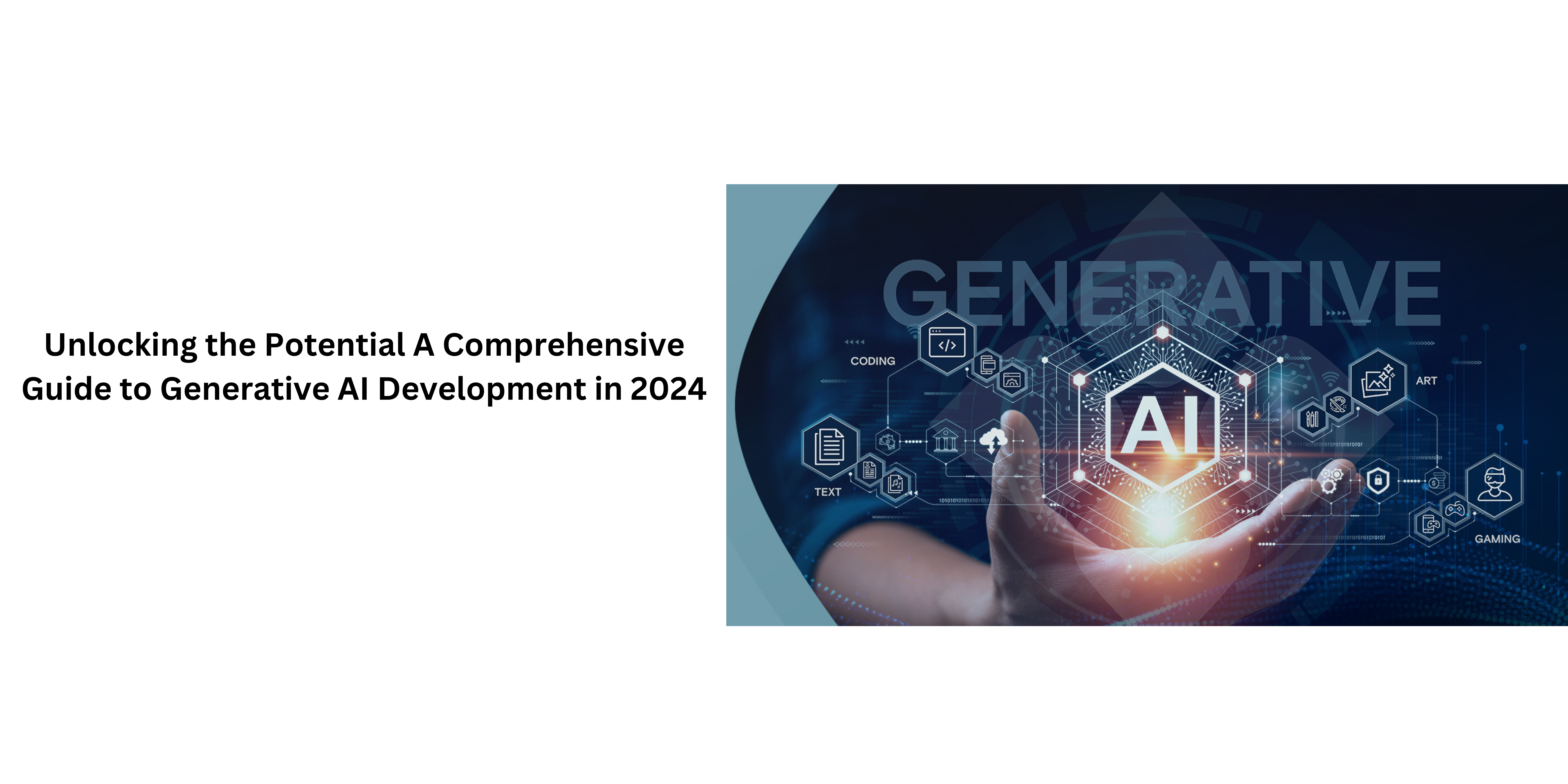In the dynamic landscape of artificial intelligence, generative models have emerged as powerful tools, shaping innovation across various industries. This guide aims to provide a thorough exploration of the current state of Generative AI, offering insights into its evolution, applications, and the underlying technologies driving its development in the year 2024.
As we delve into this comprehensive journey, we will navigate through the fundamental concepts, advanced algorithms, and intricate neural networks that constitute the backbone of generative models, especially when considering the expertise of a generative AI development company. The guide goes beyond theoretical discussions, addressing practical aspects such as data preparation, model optimization, and ethical considerations.
Real-world success stories and emerging trends will illuminate the transformative potential of Generative AI, while discussions on challenges and collaborative development aim to equip both novices and seasoned developers with the knowledge needed to navigate this exciting field. Whether you are an aspiring developer or an industry professional, join us on this exploration of the cutting-edge advancements and possibilities in Generative AI development.
Key Concepts and Fundamentals of Generative AI
Generative Artificial Intelligence (Generative AI) operates at the forefront of innovation, creating computer systems that possess the ability to generate new content, such as images, texts, or even entire datasets, mimicking the patterns observed in the training data. At its core, the key concepts and fundamentals of Generative AI revolve around the idea of leveraging neural networks to model and generate complex data distributions.
Neural networks, inspired by the human brain’s structure, are the foundational elements of Generative AI. The primary architecture for generative models is the Generative Adversarial Network (GAN) and the Variational Autoencoder (VAE). GANs consist of a generator and a discriminator engaged in a competitive process, leading to the creation of realistic outputs, while VAEs focus on encoding and decoding the latent space of data distributions.
Understanding probability distributions and statistical modeling is essential for grasping the intricacies of generative ai process. Generative models learn the underlying patterns of a dataset and then generate new instances that are statistically similar. This involves mastering concepts like probability density functions, which quantify the likelihood of different outcomes.
The training process involves exposing the model to vast amounts of diverse data, and fine-tuning the neural network’s parameters to capture and replicate complex patterns. Transfer learning, reinforcement learning, and attention mechanisms are additional concepts that enhance the capabilities of generative models, enabling them to adapt to various tasks and datasets.
In essence, the key concepts and fundamentals of Generative AI merge statistical learning, neural network architectures, and advanced algorithms to unlock the potential for machines to create, innovate, and generate content that mirrors the complexity of the real world. As we delve deeper into this guide, these foundational elements will serve as a springboard for exploring the myriad applications and advancements in the dynamic field of Generative AI.
Evolution of Generative AI Technologies
The Evolution of Generative AI Technologies has been a fascinating journey marked by continuous innovation, breakthroughs, and paradigm shifts in the landscape of artificial intelligence. In the early stages, generative models were constrained by limited computational power and dataset sizes, leading to simplistic applications. However, as computing capabilities expanded and datasets grew in complexity, the field experienced a transformative shift.
The advent of Generative Adversarial Networks (GANs) in 2014, introduced by Ian Goodfellow and his team, marked a pivotal moment in the evolution of Generative AI, especially with the advancements provided by generative AI development services. GANs pioneered a novel training approach where a generator and discriminator engage in a competitive process, driving the generator to create increasingly realistic outputs. This breakthrough opened doors to high-quality image synthesis, paving the way for applications in art, design, and content creation.
Over the years, researchers enhanced generative models by introducing architectures like Variational Autoencoders (VAEs) and incorporating attention mechanisms. These developments addressed challenges related to model stability, training convergence, and the generation of diverse and meaningful outputs.
The evolution of generative technologies also witnessed the rise of transformer architectures, such as OpenAI’s GPT (Generative Pre-trained Transformer) series, enabling models to understand and generate coherent and contextually relevant text. This not only revolutionized natural language processing but also extended generative capabilities to various applications, including chatbots, content creation, and even code generation.
In 2024, the evolution continues with the integration of reinforcement learning techniques and improved transfer learning strategies, enabling generative models to tackle complex tasks with greater efficiency and versatility. As we navigate through the unfolding advancements in this guide, it becomes evident that the evolution of Generative AI Technologies is an ongoing saga of innovation, collaboration, and the relentless pursuit of unlocking the full potential of artificial intelligence.
Applications and Use Cases in Various Industries
Generative AI has transcended its theoretical origins, finding profound applications across a spectrum of industries, reshaping processes, and driving innovation. In 2024, the diverse and transformative use cases of Generative AI underscore its potential to revolutionize how businesses operate.
Healthcare
Generative AI aids in medical image synthesis, assisting in diagnostics and treatment planning. It plays a pivotal role in generating synthetic datasets for training medical models and predicting patient outcomes.
Finance
In the financial sector, Generative AI is employed for fraud detection, risk assessment, and portfolio optimization. It analyzes historical data to generate realistic market scenarios, enhancing decision-making processes.
Retail and E-Commerce
Generative models are harnessed for personalized recommendations, virtual try-on experiences, and even generating product descriptions. This enhances customer engagement and streamlines the shopping experience.
Entertainment and Media
The entertainment industry benefits from Generative AI in content creation, video synthesis, and virtual set design. It enables the generation of realistic characters, scenes, and special effects in movies, games, and virtual reality experiences.
Manufacturing
In manufacturing, Generative AI is applied for design optimization, process simulation, and predictive maintenance. It contributes to creating efficient and cost-effective production processes.
Automotive
Generative AI aids in designing and optimizing vehicle components, improving aerodynamics, safety features, and fuel efficiency. It accelerates the innovation cycle in automotive engineering.
Marketing
Marketers leverage Generative AI for content creation, ad copy generation, and social media engagement. It helps in crafting compelling and personalized campaigns that resonate with target audiences.
Education
In education, Generative AI is utilized for personalized learning experiences, content creation, and automating administrative tasks. It adapts to individual student needs, enhancing the overall learning process.
These applications merely scratch the surface, showcasing the versatility of Generative AI across diverse sectors, especially with the insights provided by AI development services. As we delve into the intricacies of its implementation, it becomes evident that the impact of Generative AI on various industries is not only transformative but also indicative of its role in shaping the future of technology-driven solutions.
Understanding Neural Networks in Generative AI
Understanding Neural Networks in Generative AI is fundamental to grasping the intricacies of how these systems learn and generate complex data distributions. Neural networks, inspired by the structure of the human brain, form the backbone of generative models and are pivotal to their functioning.
At the core of Generative AI are architectures like Generative Adversarial Networks (GANs) and Variational Autoencoders (VAEs). GANs consist of a generator and a discriminator engaged in a competitive process. The generator creates synthetic data, aiming to fool the discriminator into believing it is real, while the discriminator strives to distinguish between real and generated data. This adversarial training process refines the generator’s ability to produce realistic outputs.
On the other hand, VAEs focus on encoding and decoding the latent space of data distributions. The encoder transforms input data into a meaningful representation in a lower-dimensional space, and the decoder reconstructs the input from this representation. VAEs offer a probabilistic approach to generative modeling, providing a structured way to sample from the learned latent space.
Understanding the layers and connections within neural networks is crucial. Layers consist of interconnected nodes or neurons, each with associated weights and biases. The intricate patterns and relationships encoded in these weights allow the network to learn complex features and correlations in the data during the training process.
The training process involves feeding the network with vast amounts of diverse data, adjusting the weights through backpropagation, and fine-tuning the model to capture the underlying patterns. Transfer learning, where pre-trained models are adapted for specific tasks, and attention mechanisms further enhance the capabilities of neural networks in Generative AI.
In summary, a nuanced understanding of neural networks, their architectures, and the training processes empowers developers to harness the potential of Generative AI, especially with the guidance provided by an AI development company. As we explore the depths of this guide, this foundational knowledge will illuminate the path to creating sophisticated generative models that can innovate and generate content across various domains.
Advanced Algorithms Driving Generative AI Development
Advanced Algorithms are the driving force behind the continuous evolution and innovation in Generative AI development, pushing the boundaries of what artificial intelligence can achieve. These sophisticated algorithms contribute to the creation of generative models that can replicate, and in some cases, surpass human-like creativity and problem-solving.
One of the pioneering algorithms in Generative AI is the Generative Adversarial Network (GAN). GANs employ a game-theoretic approach, involving a generator and a discriminator in a competitive setting. The generator produces synthetic data, while the discriminator attempts to distinguish between real and generated data. This adversarial training process results in the refinement of the generator, leading to the generation of increasingly realistic outputs.
Variational Autoencoders (VAEs) utilize probabilistic graphical models and variational inference. VAEs focus on encoding input data into a lower-dimensional latent space, allowing for the generation of new samples by sampling from this learned latent space. This probabilistic approach provides a structured method for generating diverse and meaningful outputs.
Reinforcement learning algorithms have also made significant contributions to Generative AI. By incorporating reward-based systems, reinforcement learning enables generative models to learn from interactions with the environment, refining their output based on positive or negative feedback.
Attention mechanisms, inspired by human cognitive processes, have become integral to advanced algorithms in Generative AI. These mechanisms allow models to focus on specific parts of input data, improving the model’s ability to capture long-range dependencies and intricate patterns.
As Generative AI progresses into 2024, the synergy of these advanced algorithms continues to propel the field forward. The combination of GANs, VAEs, reinforcement learning, and attention mechanisms opens new frontiers for applications ranging from creative content generation to solving complex real-world problems. The ongoing refinement of these algorithms holds the promise of unlocking even greater potential in Generative AI development.
Data Preparation and Processing for Generative Models
Data preparation and processing play a crucial role in the efficacy of Generative AI models, influencing their ability to learn and generate meaningful outputs. The quality and diversity of the dataset directly impact the model’s capacity to capture intricate patterns and variations in the data distribution.
Dataset Curation
Selecting an appropriate dataset is foundational. The dataset should be representative of the domain the generative model aims to emulate. High-quality, diverse datasets ensure that the model learns a broad spectrum of features and variations.
Preprocessing Techniques
Cleaning and preprocessing the data are essential steps. This involves handling missing values, normalizing features, and addressing outliers. Preprocessing techniques ensure that the input data is standardized and conducive to effective training.
Augmentation Strategies
Data augmentation techniques are employed to artificially expand the dataset, introducing variations that enhance the model’s robustness. Augmentation can include random rotations, flips, and changes in lighting conditions, especially useful when dealing with limited data.
Balancing Classes
In scenarios where certain classes are underrepresented, balancing techniques are applied to prevent bias in the model. This ensures that the generative model learns to generate diverse instances across all classes.
Temporal and Spatial Considerations
Depending on the application, temporal or spatial aspects of the data may be critical. Sequences in time-series data or spatial relationships in images need careful consideration during preprocessing to capture relevant patterns.
Handling Imbalanced Data
Addressing imbalanced data distributions is crucial for generative models to avoid favouring over-represented classes. Techniques such as oversampling, under sampling, or the use of specialized loss functions can be employed.
Noise Injection
Introducing controlled noise during training helps the model generalize better to unseen data. This technique prevents the model from overfitting to specific instances in the training set.
Effective data preparation ensures that the generative model is exposed to a diverse and representative set of examples, enabling it to generalize well to new and unseen instances, with the assistance provided by AI development solutions. As we explore the nuances of Generative AI, understanding the importance of meticulous data preparation becomes a cornerstone for successful model development and deployment.
Tools and Frameworks for Efficient Generative AI Development
Efficient Generative AI development is significantly influenced by the tools and frameworks available to developers, providing a structured environment for designing, training, and deploying generative models. In 2024, an array of robust tools empowers developers to navigate the complexities of Generative AI seamlessly.
TensorFlow
TensorFlow, developed by Google, is a widely-used open-source machine learning framework. Its extensive ecosystem supports the development of generative models, including popular architectures like GANs and VAEs.
PyTorch
PyTorch, maintained by Facebook, is another leading deep learning framework. Known for its dynamic computation graph, PyTorch is favored for research and development in Generative AI. Its intuitive interface allows for quick prototyping and experimentation.
Keras
Built on top of TensorFlow and Theano, Keras provides a high-level neural networks API. Its user-friendly interface is conducive to rapid prototyping, making it accessible for both beginners and experienced developers in Generative AI.
OpenAI’s GPT
OpenAI’s Generative Pre-trained Transformer (GPT) series, built on the transformer architecture, has set new standards for natural language processing and text generation. GPT-3, the latest iteration, demonstrates the power of large-scale pre-training for diverse applications.
NVIDIA CUDA and cuDNN
NVIDIA’s CUDA and cuDNN libraries leverage GPU acceleration, significantly speeding up the training and inference processes for large-scale generative models. The parallel processing capabilities of GPUs are instrumental in handling the computational demands of deep learning.
PyTorch Lightning
PyTorch Lightning is a lightweight PyTorch wrapper that simplifies the training process, making code modular and more readable. It is particularly beneficial for organizing complex Generative AI projects.
FastAI
FastAI is a high-level library built on top of PyTorch, designed to simplify the training of deep learning models. It offers tools and abstractions that make it easier for developers to implement and experiment with generative models.
These tools and frameworks provide a solid foundation for Generative AI development, catering to a diverse range of applications. As technology continues to advance, the accessibility and capabilities of these tools will likely play a pivotal role in democratizing Generative AI and driving further innovations in the field.
Ethical Considerations in Generative AI Applications
Ethical considerations in Generative AI applications are paramount as these technologies evolve and find their way into diverse domains. Understanding and addressing ethical concerns ensures responsible development and deployment, safeguarding against potential risks and societal implications.
Bias and Fairness
Generative models are prone to learning biases present in training data. Ethical development demands vigilant efforts to identify and mitigate biases, ensuring fair and unbiased outcomes. Strategies such as diverse dataset representation and fairness-aware algorithms help address this concern.
Privacy Concerns
Generative models may inadvertently generate outputs that contain sensitive or private information from the training data. Developers must implement privacy-preserving techniques, including data anonymization and secure training protocols, to protect individuals’ privacy.
Misuse and Deepfakes
The capability of Generative AI to create highly realistic synthetic content raises concerns about its misuse for creating deepfakes and misinformation. Ethical guidelines should address the responsible use of such technologies and the potential consequences of malicious intent.
Accountability and Transparency
Transparent AI development is essential for accountability. Developers should provide clear documentation, disclose limitations, and offer insights into the decision-making processes of generative models. This transparency fosters trust and accountability in the deployment of these technologies.
Robustness and Security
Ensuring the robustness and security of generative models is crucial to prevent adversarial attacks. Ethical considerations include implementing robust architectures and exploring potential vulnerabilities during model development.
Environmental Impact
Training large-scale generative models can be computationally intensive, contributing to a significant carbon footprint. Ethical AI development involves exploring energy-efficient training methods and adopting sustainable practices to minimize environmental impact.
Human-AI Collaboration
Ethical considerations extend to how humans interact with generative AI systems. Guidelines should promote human-AI collaboration, emphasizing the augmentation of human capabilities rather than replacement, and ensuring that AI systems serve human interests.
As Generative AI applications continue to proliferate, a proactive approach to ethical considerations becomes imperative. Developers, researchers, and policymakers need to collaborate to establish comprehensive ethical frameworks, fostering responsible innovation and ensuring that Generative AI technologies contribute positively to society.
Challenges and Solutions in Generative AI Development
Generative AI development brings forth a set of challenges that necessitate innovative solutions for the field to progress effectively. Understanding and addressing these challenges are crucial for advancing the capabilities of generative models.
Mode Collapse
Challenge: Generative models, especially GANs, may suffer from mode collapse, where the generator fails to explore the entire data distribution, resulting in limited diversity in generated outputs. Solution: Introducing techniques like minibatch discrimination and incorporating diversity-promoting objectives helps mitigate mode collapse, fostering a more varied output.
Training Stability
Challenge: Achieving stable training for generative models can be challenging, with issues such as oscillations and convergence difficulties. Solution: Techniques like spectral normalization and careful initialization methods contribute to stable training, enhancing the convergence and overall performance of the models.
Evaluation Metrics
Challenge: Assessing the quality of generative models poses challenges due to the lack of universally accepted evaluation metrics. Solution: Utilizing a combination of metrics such as Inception Score, Frechet Inception Distance (FID), and human evaluation helps provide a comprehensive assessment of the generated outputs.
Computational Intensity
Challenge: Training large-scale generative models can be computationally demanding and resource-intensive. Solution: Efficient parallelization, leveraging distributed computing, and optimizing algorithms for hardware accelerators like GPUs contribute to more computationally efficient training.
Ethical Concerns
Challenge: Ethical considerations, including biases in generated outputs and the potential for misuse in deepfake creation, need careful consideration. Solution: Implementing fairness-aware algorithms, conducting ethical impact assessments, and promoting responsible use guidelines address ethical concerns in generative AI development.
Generalization to Unseen Data
Challenge: Ensuring that generative models generalize well to unseen data and diverse scenarios is a persistent challenge. Solution: Techniques like transfer learning, meta-learning, and data augmentation enhance the generalization capabilities of generative models, enabling them to handle a broader range of inputs.
Navigating these challenges requires a collaborative effort from researchers and developers, pushing the boundaries of innovation while maintaining a focus on ethical considerations and responsible deployment of Generative AI technologies. Addressing these challenges head-on fosters the evolution of generative models and their application in diverse domains.
Real-world Success Stories of Generative AI Implementation
Generative AI has witnessed remarkable success stories across various industries, showcasing its transformative potential in real-world applications. These success stories highlight the versatility and impact of generative models in solving complex problems and driving innovation.
Art and Design
Generative models, particularly GANs, have been utilized to create unique and compelling artworks. Artists and designers leverage these models to generate original pieces, combining human creativity with the algorithms’ ability to produce diverse and aesthetically pleasing visual content.
Healthcare Imaging
In the healthcare sector, generative models contribute to medical imaging advancements. Models like CycleGANs aid in translating medical images from one modality to another, enabling better diagnosis and treatment planning.
Content Creation in Gaming
Generative AI is revolutionizing content creation in the gaming industry. Procedural content generation using generative models allows developers to generate vast and realistic game environments, enhancing the gaming experience for players.
DeepFake Detection
In response to the rise of deepfakes, generative models are being employed for deepfake detection. AI algorithms can analyze video and image content to identify signs of manipulation, contributing to the development of tools for detecting and preventing the spread of misinformation.
Generative models like GPT-3 have demonstrated exceptional capabilities in natural language processing. Applications range from generating coherent and contextually relevant text to powering advanced chatbots that engage in meaningful and context-aware conversations.
Fashion Design
In the fashion industry, generative models assist designers in creating novel and trend-setting designs. These models analyze existing fashion trends and generate innovative designs, influencing the creative process and fostering new styles.
These success stories underscore the potential of generative AI to revolutionize industries and redefine traditional approaches. As technology continues to advance, these real-world implementations serve as beacons, inspiring further exploration and innovation in the field of Generative AI.
Trends Shaping the Future of Generative AI
The future of the generative AI company is marked by exciting and transformative trends that are shaping the landscape of artificial intelligence. As we look ahead, several key trends are expected to drive advancements in generative AI, influencing its applications and capabilities.
Cross-Modal Learning
Future generative models are likely to excel in cross-modal learning, enabling them to seamlessly generate and understand content across different modalities such as text, images, and audio. This trend will facilitate more holistic and context-aware AI systems.
Zero-Shot and Few-Shot Learning
The evolution of generative models will emphasize zero-shot and few-shot learning capabilities. Models like OpenAI’s GPT-4 are expected to exhibit improved adaptability to new tasks with minimal training data, opening avenues for more flexible and user-friendly applications.
Integrating Reinforcement Learning
Generative models are increasingly integrating reinforcement learning techniques, allowing them to learn from interactions with the environment. This trend enhances the models’ ability to adapt to dynamic scenarios and optimize decision-making processes.
Explainability and Interpretability
Future generative models will prioritize explainability and interpretability. As AI systems become more intricate, understanding the reasoning behind their outputs is crucial for building trust and ensuring ethical deployment.
Personalization and Customization
Generative models are expected to become more adept at personalization, tailoring outputs to individual preferences and needs. This trend will be prominent in applications such as content generation, recommendation systems, and user interfaces.
Federated Learning for Privacy
To address privacy concerns, federated learning is likely to gain prominence in generative AI. This approach allows models to be trained across decentralized devices, preserving user data locally and mitigating privacy risks.
GANs for Data Augmentation
Generative Adversarial Networks (GANs) will continue to play a crucial role in data augmentation. These models will be increasingly utilized to generate realistic and diverse synthetic data, enhancing the training of machine learning models in various domains.
These trends collectively depict a future where Generative AI for developers becomes more versatile, adaptive, and ethical. The ongoing innovation in this field promises to unlock new possibilities, revolutionizing industries and shaping the way we interact with AI-driven systems in the years to come.
Optimizing Model Performance and Training Techniques
Optimizing model performance and refining training techniques are critical aspects of Generative AI development, ensuring that models achieve high-quality results efficiently. As the field advances, researchers and developers continually explore strategies to enhance the performance of generative models.
Architecture Innovations
Advancements in model architectures, particularly for Generative Adversarial Networks (GANs) and Variational Autoencoders (VAEs), play a pivotal role. Researchers continuously refine and propose novel architectures to improve the stability, convergence, and overall performance of generative models.
Transfer Learning and Pre-training
Leveraging transfer learning and pre-training techniques allows models to benefit from knowledge acquired in one domain and apply it to another. Pre-training on large datasets or using pre-trained models accelerates convergence and enhances the generalization of generative models.
Adaptive Learning Rates
Adaptive learning rate algorithms, such as Adam and AdaGrad, dynamically adjust learning rates during training. This helps prevent issues like slow convergence or overshooting, optimizing the overall training process.
Regularization Techniques
Techniques like dropout and weight regularization prevent overfitting by introducing controlled randomness and penalizing large weights. These regularization methods contribute to improved generalization, especially in scenarios with limited training data.
Batch Normalization
Batch normalization normalizes intermediate representations within a neural network, mitigating internal covariate shift. This stabilizes and accelerates training, leading to faster convergence and improved model performance.
Data Augmentation
Augmenting the training dataset with variations of the existing data enhances model robustness and generalization. Techniques like rotation, scaling, and flipping contribute to a more diverse training set, leading to better performance on unseen data.
Hyperparameter Tuning
Systematic tuning of hyperparameters, including learning rates, batch sizes, and model complexities, is essential. This optimization process involves iterative experimentation to identify the most effective configuration for a specific generative model and task.
Early Stopping and Model Checkpoints
Implementing early stopping prevents overfitting by halting training when performance on a validation set plateaus. Model checkpoints ensure that the best-performing model is saved, allowing developers to avoid potential setbacks and track progress effectively.
Optimizing model performance in generative AI software development involves a combination of architectural innovations, algorithmic improvements, and strategic choices in training methodologies. As researchers delve deeper into these techniques, the field of generative AI software development continues to advance, unlocking new possibilities and pushing the boundaries of what generative models can achieve.
Collaborative Development in Generative AI Projects
Collaborative development is a cornerstone in advancing Generative AI projects, fostering collective expertise, and accelerating innovation. In the dynamic landscape of artificial intelligence, where Generative AI plays a pivotal role, collaborative efforts bring diverse perspectives and skill sets together to tackle complex challenges.
Interdisciplinary Collaboration
Generative AI projects often require expertise from various disciplines, including computer science, mathematics, neuroscience, and domain-specific fields. Collaborative development facilitates interdisciplinary collaboration, enabling professionals with different backgrounds to contribute complementary insights.
Open-source Contributions
Many Generative AI projects thrive on open-source collaboration. Platforms like GitHub provide a collaborative environment where researchers and developers from around the world can contribute code, share models, and collectively enhance the state of the art in Generative AI.
Shared Datasets and Benchmarks
Collaborative efforts extend to the creation and sharing of datasets and benchmarks. Shared resources enable researchers to evaluate and compare the performance of different models consistently, driving advancements in the field.
Research Partnerships
Collaborations between academia and industry contribute significantly to Generative AI development. Research partnerships foster knowledge exchange, access to resources, and the translation of theoretical advancements into practical applications.
Community Building
Collaborative development encourages the formation of communities around specific Generative AI topics. These communities serve as platforms for knowledge sharing, discussions, and the dissemination of best practices, creating a supportive ecosystem for developers and researchers.
Hackathons and Competitions
Events like hackathons and AI competitions provide opportunities for collaborative problem-solving. Participants from diverse backgrounds come together to address specific challenges, encouraging creative solutions and the rapid advancement of Generative AI techniques.
Code Review and Feedback
Collaborative development emphasizes the importance of code review and feedback. Peer reviews enhance the quality of code, identify potential issues, and promote best practices, ensuring that Generative AI projects adhere to high standards of reliability and performance.
In the fast-paced and evolving field of Generative AI overview, collaborative development is essential for pushing the boundaries of what is achievable. By fostering collaboration, the community not only addresses existing challenges more effectively but also lays the groundwork for future breakthroughs, propelling the field forward collectively.
The Key Takeaway
In conclusion, the landscape of Generative AI is marked by continuous innovation, collaborative development, and the pursuit of ethical and responsible practices. As we navigate through the diverse applications, challenges, and trends outlined in this guide, it becomes evident that Generative AI is not merely a technological advancement but a transformative force shaping the future of artificial intelligence.
The success stories across industries showcase the potential of generative AI services to revolutionize art, healthcare, gaming, and more. Yet, ethical considerations, robust model optimization, and collaborative efforts remain integral to unleashing the full potential of generative AI services. Looking ahead, the trends of cross-modal learning, interpretability, and federated learning underscore a future where generative AI services become more adaptable, transparent, and user-centric.
As the field evolves, it is the collaborative endeavors, ethical frameworks, and technological innovations that will drive Generative AI towards greater heights, offering a glimpse into the limitless possibilities of intelligent, creative machines.











